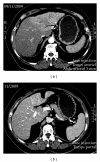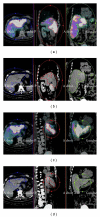Utility of Quantitative Tc-MAA SPECT/CT for yttrium-Labelled Microsphere Treatment Planning: Calculating Vascularized Hepatic Volume and Dosimetric Approach
- PMID: 21822489
- PMCID: PMC3147134
- DOI: 10.1155/2011/398051
Utility of Quantitative Tc-MAA SPECT/CT for yttrium-Labelled Microsphere Treatment Planning: Calculating Vascularized Hepatic Volume and Dosimetric Approach
Abstract
Objectives. The aim of this study was to assess the effectiveness of SPECT/CT for volume measurements and to report a case illustrating the major impact of SPECT/CT in calculating the vascularized liver volume and dosimetry prior to injecting radiolabelled yttrium-90 microspheres (Therasphere). Materials and Methods. This was a phantom study, involving volume measurements carried out by two operators using SPECT and SPECT/CT images. The percentage of error for each method was calculated, and interobserver reproducibility was evaluated. A treatment using Therasphere was planned in a patient with three hepatic arteries, and the quantitative analysis of SPECT/CT for this patient is provided. Results. SPECT/CT volume measurements proved to be accurate (mean error <6% for volumes ≥16 cm(3)) and reproductive (interobserver agreement = 0.9). In the case report, (99m)Tc-MAA SPECT/CT identified a large liver volume, not previously identified with angiography, which was shown to be vascularized after selective MAA injection into an arterial branch, resulting in a large modification in the activity of Therasphere used. Conclusions. MAA SPECT/CT is accurate for vascularized liver volume measurements, providing a valuable contribution to the therapeutic planning of patients with complex hepatic vascularization.
Figures





References
-
- Raoul JL, Boucher E, Rolland Y, Garin E. Treatment of hepatocellular carcinoma with intra-arterial injection of radionuclides. Nature Reviews Gastroenterology and Hepatology. 2010;7(1):41–49. - PubMed
-
- Houle S, Yip TCK, Shepherd FA, et al. Hepatocellular carcinoma: pilot trial of treatment with Y-90 microspheres. Radiology. 1989;172(3):857–860. - PubMed
-
- Shepherd FA, Rotstein LE, Houle S, Yip TCK, Paul K, Sniderman KW. A phase I dose escalation trial of yttrium-90 microspheres in the treatment of primary hepatocellular carcinoma. Cancer. 1992;70(9):2250–2254. - PubMed
-
- Salem R, Thurston KG, Carr BI, Goin JE, Geschwind JFH. Yttrium-90 microspheres: radiation therapy for unresectable liver cancer. Journal of Vascular and Interventional Radiology. 2002;13(9):S223–S229. - PubMed
-
- Salem R, Thurston KG. Radioembolization with 90yttrium microspheres: a state-of-the-art brachytherapy treatment for primary and secondary liver malignancies—part 1: technical and methodologic considerations. Journal of Vascular and Interventional Radiology. 2006;17(8):1251–1278. - PubMed
LinkOut - more resources
Full Text Sources

